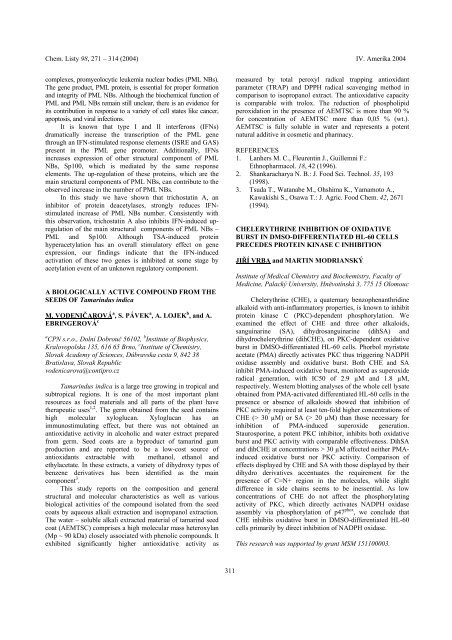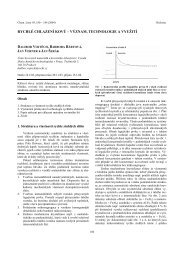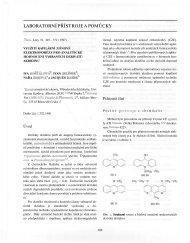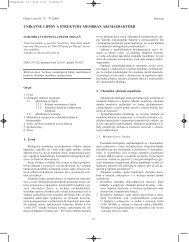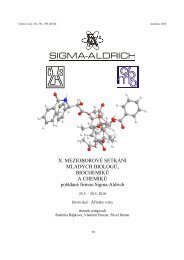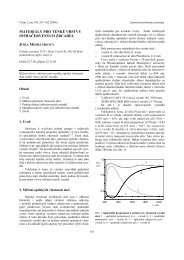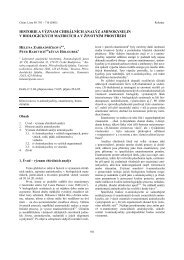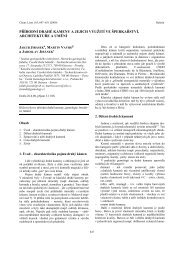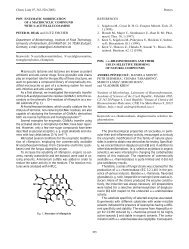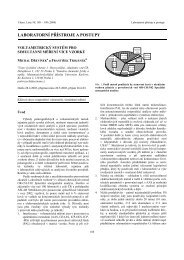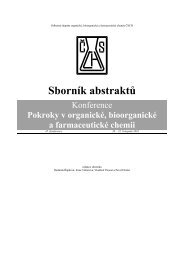iv. mezioborové setkênè mladðch biologů ... - Chemické listy
iv. mezioborové setkênè mladðch biologů ... - Chemické listy
iv. mezioborové setkênè mladðch biologů ... - Chemické listy
You also want an ePaper? Increase the reach of your titles
YUMPU automatically turns print PDFs into web optimized ePapers that Google loves.
Chem. Listy 98, 271 – 314 (2004) IV. Amerika 2004.<br />
complexes, promyeolocytic leukemia nuclear bodies (PML NBs).<br />
The gene product, PML protein, is essential for proper formation<br />
and integrity of PML NBs. Although the biochemical function of<br />
PML and PML NBs remain still unclear, there is an evidence for<br />
its contribution in response to a variety of cell states like cancer,<br />
apoptosis, and viral infections.<br />
It is known that type I and II interferons (IFNs)<br />
dramatically increase the transcription of the PML gene<br />
through an IFN-stimulated response elements (ISRE and GAS)<br />
present in the PML gene promoter. Additionally, IFNs<br />
increases expression of other structural component of PML<br />
NBs, Sp100, which is mediated by the same response<br />
elements. The up-regulation of these proteins, which are the<br />
main structural components of PML NBs, can contribute to the<br />
observed increase in the number of PML NBs.<br />
In this study we have shown that trichostatin A, an<br />
inhibitor of protein deacetylases, strongly reduces IFNstimulated<br />
increase of PML NBs number. Consistently with<br />
this observation, trichostatin A also inhibits IFN-induced upregulation<br />
of the main structural components of PML NBs –<br />
PML and Sp100. Although TSA-induced protein<br />
hyperacetylation has an overall stimulatory effect on gene<br />
expression, our findings indicate that the IFN-induced<br />
act<strong>iv</strong>ation of these two genes is inhibited at some stage by<br />
acetylation event of an unknown regulatory component.<br />
A BIOLOGICALLY ACTIVE COMPOUND FROM THE<br />
SEEDS OF Tamarindus indica<br />
M. VODENIČAROVÁ a , S. PÁVEK a , A. LOJEK b , and A.<br />
EBRINGEROVÁ c<br />
a CPN s.r.o., Dolní Dobrouč 56102, b Institute of Biophysics,<br />
Kralovopolska 135, 616 65 Brno, c Institute of Chemistry,<br />
Slovak Academy of Sciences, Dúbravska cesta 9, 842 38<br />
Bratislava, Slovak Republic<br />
vodenicarova@contipro.cz<br />
Tamarindus indica is a large tree growing in tropical and<br />
subtropical regions. It is one of the most important plant<br />
resources as food materials and all parts of the plant have<br />
therapeutic uses 1,2 . The germ obtained from the seed contains<br />
high molecular xyloglucan. Xyloglucan has an<br />
immunostimulating effect, but there was not obtained an<br />
antioxidat<strong>iv</strong>e act<strong>iv</strong>ity in alcoholic and water extract prepared<br />
from germ. Seed coats are a byproduct of tamarind gum<br />
production and are reported to be a low-cost source of<br />
antioxidants extractable with methanol, ethanol and<br />
ethylacetate. In these extracts, a variety of dihydroxy types of<br />
benzene der<strong>iv</strong>at<strong>iv</strong>es has been identified as the main<br />
component 3 .<br />
This study reports on the composition and general<br />
structural and molecular characteristics as well as various<br />
biological act<strong>iv</strong>ities of the compound isolated from the seed<br />
coats by aqueous alkali extraction and isopropanol extraction.<br />
The water – soluble alkali extracted material of tamarind seed<br />
coat (AEMTSC) comprises a high molecular mass heteroxylan<br />
(Mp ~ 90 kDa) closely associated with phenolic compounds. It<br />
exhibited significantly higher antioxidat<strong>iv</strong>e act<strong>iv</strong>ity as<br />
measured by total peroxyl radical trapping antioxidant<br />
parameter (TRAP) and DPPH radical scavenging method in<br />
comparison to isopropanol extract. The antioxidat<strong>iv</strong>e capacity<br />
is comparable with trolox. The reduction of phospholipid<br />
peroxidation in the presence of AEMTSC is more than 90 %<br />
for concentration of AEMTSC more than 0,05 % (wt.).<br />
AEMTSC is fully soluble in water and represents a potent<br />
natural addit<strong>iv</strong>e in cosmetic and pharmacy.<br />
REFERENCES<br />
1. Lanhers M. C., Fleurentin J., Guillemni F.:<br />
Ethnopharmacol. 18, 42 (1996).<br />
2. Shankaracharya N. B.: J. Food Sci. Technol. 35, 193<br />
(1998).<br />
3. Tsuda T., Watanabe M., Ohshima K., Yamamoto A.,<br />
Kawakishi S., Osawa T.: J. Agric. Food Chem. 42, 2671<br />
(1994).<br />
CHELERYTHRINE INHIBITION OF OXIDATIVE<br />
BURST IN DMSO-DIFFERENTIATED HL-60 CELLS<br />
PRECEDES PROTEIN KINASE C INHIBITION<br />
JIŘÍ VRBA and MARTIN MODRIANSKÝ<br />
Institute of Medical Chemistry and Biochemistry, Faculty of<br />
Medicine, Palacký Un<strong>iv</strong>ersity, Hněvotínská 3, 775 15 Olomouc<br />
Chelerythrine (CHE), a quaternary benzophenanthridine<br />
alkaloid with anti-inflammatory properties, is known to inhibit<br />
protein kinase C (PKC)-dependent phosphorylation. We<br />
examined the effect of CHE and three other alkaloids,<br />
sanguinarine (SA), dihydrosanguinarine (dihSA) and<br />
dihydrochelerythrine (dihCHE), on PKC-dependent oxidat<strong>iv</strong>e<br />
burst in DMSO-differentiated HL-60 cells. Phorbol myristate<br />
acetate (PMA) directly act<strong>iv</strong>ates PKC thus triggering NADPH<br />
oxidase assembly and oxidat<strong>iv</strong>e burst. Both CHE and SA<br />
inhibit PMA-induced oxidat<strong>iv</strong>e burst, monitored as superoxide<br />
radical generation, with IC50 of 2.9 µM and 1.8 µM,<br />
respect<strong>iv</strong>ely. Western blotting analyses of the whole cell lysate<br />
obtained from PMA-act<strong>iv</strong>ated differentiated HL-60 cells in the<br />
presence or absence of alkaloids showed that inhibition of<br />
PKC act<strong>iv</strong>ity required at least ten-fold higher concentrations of<br />
CHE (> 30 µM) or SA (> 20 µM) than those necessary for<br />
inhibition of PMA-induced superoxide generation.<br />
Staurosporine, a potent PKC inhibitor, inhibits both oxidat<strong>iv</strong>e<br />
burst and PKC act<strong>iv</strong>ity with comparable effect<strong>iv</strong>eness. DihSA<br />
and dihCHE at concentrations > 30 µM affected neither PMAinduced<br />
oxidat<strong>iv</strong>e burst nor PKC act<strong>iv</strong>ity. Comparison of<br />
effects displayed by CHE and SA with those displayed by their<br />
dihydro der<strong>iv</strong>at<strong>iv</strong>es accentuates the requirement for the<br />
presence of C=N+ region in the molecules, while slight<br />
difference in side chains seems to be inessential. As low<br />
concentrations of CHE do not affect the phosphorylating<br />
act<strong>iv</strong>ity of PKC, which directly act<strong>iv</strong>ates NADPH oxidase<br />
assembly via phosphorylation of p47 phox , we conclude that<br />
CHE inhibits oxidat<strong>iv</strong>e burst in DMSO-differentiated HL-60<br />
cells primarily by direct inhibition of NADPH oxidase.<br />
This research was supported by grant MSM 151100003.<br />
311


